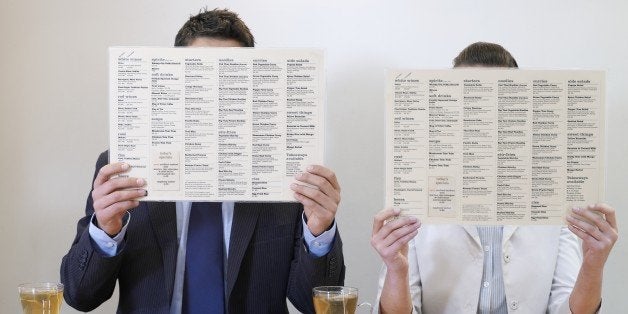
What are some examples of restaurants using psychology to manipulate our spending and eating habits?: originally appeared on Quora: The best answer to any question. Ask a question, get a great answer. Learn from experts and access insider knowledge. You can follow Quora on Twitter, Facebook, and Google+.
Answer by Neil Eisenberg, Graduated Psychology Degree UCLA
The next time you dine out, take along a copy of this list and count how many of the following psychological ploys your favorite restaurant uses.
1. Restaurants utilize particularly imaginative language to make menu items more attractive and appealing. Descriptive labels will generally increase sales by as much as 27%, according to a Cornell University study, compared to foods without. Some recognizable descriptions are; handcrafted, triple-basted, slow-cooked, golden-brown, hand-selected, fresh from the oven, all of which bring the diner closer to the sensory experience the restaurant wants to impart.
2. Restaurants use photographs to entice diners to purchase specific menu items. An attractive picture alongside any food tends to increase sales of that item by as much as 30 percent.
3. Restaurants will limit your choices by featuring; try all samplers, tapas, or fixed menus. In essence they remove the responsibility people feel when choosing what to eat.
It is psychologically more effective for restaurants to limit their selection to the recognized six items per category in fast-food restaurants, and seven (to a maximum of 10) items per category in fine dining establishments.
4. Restaurants design their menus with the same attention to detail as they prepare your food. The upper right corner is prime real estate. It is where your eyes will go on a blank sheet of paper or in a magazine. That is exactly where the most lucrative items will be placed. From the top right your eyes will normally shift to the top left, which is where the appetizers will be. Just under the appetizers you will find salads.
Another trick is to create blank space around high-profit items by placing them in boxes or separating them from the rest of the options. Placing "negative" space around any food calls attention to it and promotes sales.
5. Restaurants scrutinize your reading patterns and consider scan-paths, which are a series of eye fixations that can be studied to see how people read certain things.
According to research conducted at Cornell University, a third of all diners are likely to order the first item their eye is drawn too. As a result, restaurants will put their more profitable items in the upper-right corner. This strategy is based on the primacy effect, which states people remember the items at the beginning of a list best. Another reason this works is that seeing a really expensive dish at first glance will make the rest of the menu seem reasonably priced by comparison.
Restaurants place their main most focus on the entrees. According to research most diners scan the entire menu like a book, but focus most of their attention on the entrees.
6. Restaurants use expensive items to draw you to the cheaper items. Restaurants also use extremely expensive foods as decoys. The rationale being, you probably won't buy it, but you'll find something cheaper since it will look more reasonable.
7. Restaurants will visually highlight foods in bold, colored or fancier typeface, accompanied with photographs, or singled out in a box, as they will appear more special. However, extremely high-end restaurants tend to avoid this strategy because it will make them look "tasteless", no pun intended.
8. Restaurants are very tricky with their numbers. Menu designers (yes, there are people who actually make a living as menu designers) recognize prices ending in 9, such as $9.99, tend to signify value, but not quality. As a result, more prices now end in .95 instead of .99 because they have a "friendlier" feel. More and more restaurants are pricing without any cents whatsoever because it makes the menu cleaner, simpler and easier to read.
9. Restaurants don't use dollar signs. A dollar sign is one of the top things restaurants now avoid because it immediately reminds diners that they are spending money. According to Cornell University research, guests issued a menu without dollar signs spent significantly more than those who received a menu with dollar signs.
10. Restaurants connect food to family members. Diners are especially drawn to relational names, such as grandma, aunt and grandparents. As an example, people are more likely to buy Grandma's warm homemade cookies or Aunt Clara's famous apple pie. Names can also add a hint of nostalgia for diners.
